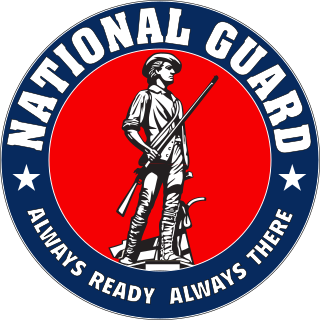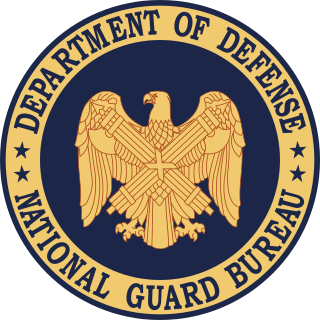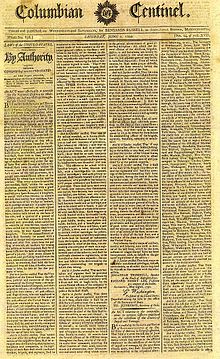
A militia is generally an army or some other fighting organization of non-professional and/or part-time soldiers; citizens of a country, or subjects of a state, who may perform military service during a time of need, as opposed to a professional force of regular, full-time military personnel; or, historically, to members of a warrior-nobility class. When acting independently militias are generally unable to hold ground against regular forces; militias commonly support regular troops by skirmishing, holding fortifications, or conducting irregular warfare, instead of undertaking offensive campaigns by themselves. Local civilian laws often limit militias to serve only in their home region, and to serve only for a limited time; this further reduces their use in long military campaigns. Militias may also, however, serve as a pool of available manpower for regular forces to draw from, particularly in emergencies.

The National Guard is a state-based military force that becomes part of the reserve components of the United States Army and the United States Air Force when activated for federal missions. It is a military reserve force composed of National Guard military members or units of each state and the territories of Guam, the Virgin Islands, Puerto Rico, and the District of Columbia, for a total of 54 separate organizations. It is officially created under Congress's Article 1 Section 8 ability to 'raise and support armies'. All members of the National Guard are also members of the organized militia of the United States as defined by 10 U.S.C. § 246. National Guard units are under the dual control of the state governments and the federal government.

The Posse Comitatus Act is a United States federal law signed on June 18, 1878, by President Rutherford B. Hayes which limits the powers of the federal government in the use of federal military personnel to enforce domestic policies within the United States. Congress passed the Act as an amendment to an army appropriation bill following the end of Reconstruction and updated it in 1956 and 1981.

The Continental Army was the army of the United Colonies representing the Thirteen Colonies and later the United States during the American Revolutionary War. It was formed on June 14, 1775 by a resolution passed by the Second Continental Congress, meeting in Philadelphia after the war's outbreak. The Continental Army was created to coordinate military efforts of the colonies in the war against the British, who sought to maintain control over the American colonies. General George Washington was appointed commander-in-chief of the Continental Army and maintained this position throughout the war.

In the United States, military conscription, commonly known as the draft, has been employed by the U.S. federal government in six conflicts: the American Revolutionary War, the American Civil War, World War I, World War II, the Korean War, and the Vietnam War. The fourth incarnation of the draft came into being in 1940, through the Selective Training and Service Act. It was the country's first peacetime draft. From 1940 until 1973, during both peacetime and periods of conflict, men were drafted to fill vacancies in the U.S. Armed Forces that could not be filled through voluntary means. Active conscription in the United States ended in 1973, when the U.S. Armed Forces moved to an all-volunteer military. However, conscription remains in place on a contingency basis and all male U.S. citizens, regardless of where they live, and male immigrants, whether documented or undocumented, residing within the United States, who are 18 through 25 are required to register with the Selective Service System. United States federal law also continues to provide for the compulsory conscription of men between the ages of 17 and 45 and certain women for militia service pursuant to Article I, Section 8 of the United States Constitution and 10 U.S. Code § 246.

The National Guard Bureau is the federal instrument responsible for the administration of the National Guard established by the United States Congress as a joint bureau of the Department of the Army and the Department of the Air Force. It was created by the Militia Act of 1903. The National Defense Authorization Act for Fiscal Year 2008, elevated the National Guard to a joint function of the Department of Defense. The 2007 NDAA, from the previous year, elevated the chief of the National Guard Bureau from a lieutenant general to a four-star general.

The Regular Army of the United States succeeded the Continental Army as the country's permanent, professional land-based military force. In modern times the professional core of the United States Army continues to be called the Regular Army. From the time of the American Revolution until after the Spanish–American War, state militias and volunteer regiments organized by the states supported the smaller Regular Army of the United States. These volunteer regiments came to be called United States Volunteers (USV) in contrast to the Regular United States Army (USA). During the American Civil War, about 97 percent of the Union Army was United States Volunteers.

The Selective Service Act of 1917 or Selective Draft Act authorized the United States federal government to raise a national army for service in World War I through conscription. It was envisioned in December 1916 and brought to President Woodrow Wilson's attention shortly after the break in relations with Germany in February 1917. The Act itself was drafted by then-Captain Hugh S. Johnson after the United States entered World War I by declaring war on Germany. The Act was canceled with the end of the war on November 11, 1918. The Act was upheld as constitutional by the United States Supreme Court in 1918.

The Insurrection Act of 1807 is a United States federal law that empowers the President of the United States to deploy U.S. military and federalized National Guard troops within the United States in particular circumstances, such as to suppress civil disorder, insurrection, or rebellion.

The Militia Act of 1862 was an Act of the 37th United States Congress, during the American Civil War, that authorized a militia draft within a state when the state could not meet its quota with volunteers. The Act, for the first time, also allowed African-Americans to serve in the militias as soldiers and war laborers.

The militia of the United States, as defined by the U.S. Congress, has changed over time. During colonial America, all able-bodied men of a certain age range were members of the militia, depending on each colony's rule. Individual towns formed local independent militias for their own defense. The year before the US Constitution was ratified, The Federalist Papers detailed the founders' paramount vision of the militia in 1787. The new Constitution empowered Congress to "organize, arm, and discipline" this national military force, leaving significant control in the hands of each state government.

The National Defense Act of 1916, Pub. L. 64–85, 39 Stat. 166, enacted June 3, 1916, was a United States federal law that updated the Militia Act of 1903, which related to the organization of the military, particularly the National Guard. The principal change of the act was to supersede provisions as to exemptions. The 1916 act included an expansion of the Army and the National Guard, the creation of an Officers' and an Enlisted Reserve Corps, and the creation of a Reserve Officers' Training Corps. The President was also given expanded authority to federalize the National Guard, with changes to the duration and the circumstances under which he could call it up. The Army began the creation of an Aviation arm, and the federal government took steps to ensure the immediate availability of wartime weapons and equipment by contracting in advance for production of gunpowder and other material.

The Federalist Era in American history ran from 1788 to 1800, a time when the Federalist Party and its predecessors were dominant in American politics. During this period, Federalists generally controlled Congress and enjoyed the support of President George Washington and President John Adams. The era saw the creation of a new, stronger federal government under the United States Constitution, a deepening of support for nationalism, and diminished fears of tyranny by a central government. The era began with the ratification of the United States Constitution and ended with the Democratic-Republican Party's victory in the 1800 elections.
National service in the United States has a long tradition, extending to the founding of the country. National service takes multiple forms in the U.S., including community service, military service, and other forms.

The Militia Act of 1903, also known as the Efficiency in Militia Act of 1903 or the Dick Act, was legislation enacted by the United States Congress to create what would become the modern National Guard from a subset of the militia, and codify the circumstances under which the Guard could be federalized. It also provided federal funds to pay for equipment and training, including annual summer encampments. The new National Guard was to organize units of similar form and quality to those of the regular Army, and intended to achieve the same training, education, and readiness requirements as active duty units.

The military forces of the Confederate States, also known as Confederate forces, were the military services responsible for the defense of the Confederacy during its existence (1861–1865).
United States Volunteers also known as U.S. Volunteers, U.S. Volunteer Army, or other variations of these, were military volunteers called upon during wartime to assist the United States Army but who were separate from both the Regular Army and the militia.
On April 15, 1861, at the start of the American Civil War, U.S. President Abraham Lincoln called for a 75,000-man militia to serve for three months following the bombardment and surrender of Fort Sumter. Some southern states refused to send troops against the neighboring Deep South slave states of South Carolina, Mississippi, Florida, Alabama, Georgia, Louisiana, and Texas. The result was that most states in the Upper South of Virginia, Arkansas, North Carolina, and Tennessee also declared secession from the United States and joined the Confederate States.
The Adjutant General of North Carolina is the head of the North Carolina National Guard. The position was created in 1806, when the Militia Acts of 1792 required the state to establish the position to better train the state militia. The office is appointed by the Governor of North Carolina and requires five years prior military service.
Martin v. Mott, 25 U.S. 19 (1827) was a United States Supreme Court case concerning the president of the United States’ emergency powers and the authority to activate state militias for federal service. The court heard the case of Jacob E. Mott, a militia private who disobeyed orders to mobilize for service during the war of 1812 and then appealed his subsequent court-martial. The court’s ruling in the case against the militiaman had a significant impact on executive powers during national emergencies, according to legal scholars, and has been used to interpret the Insurrection Act of 1807.












